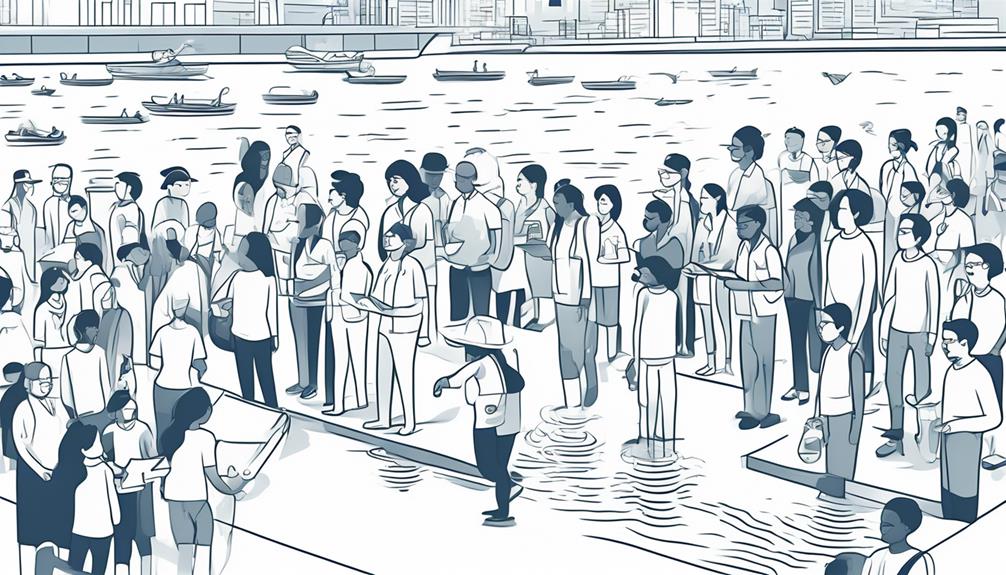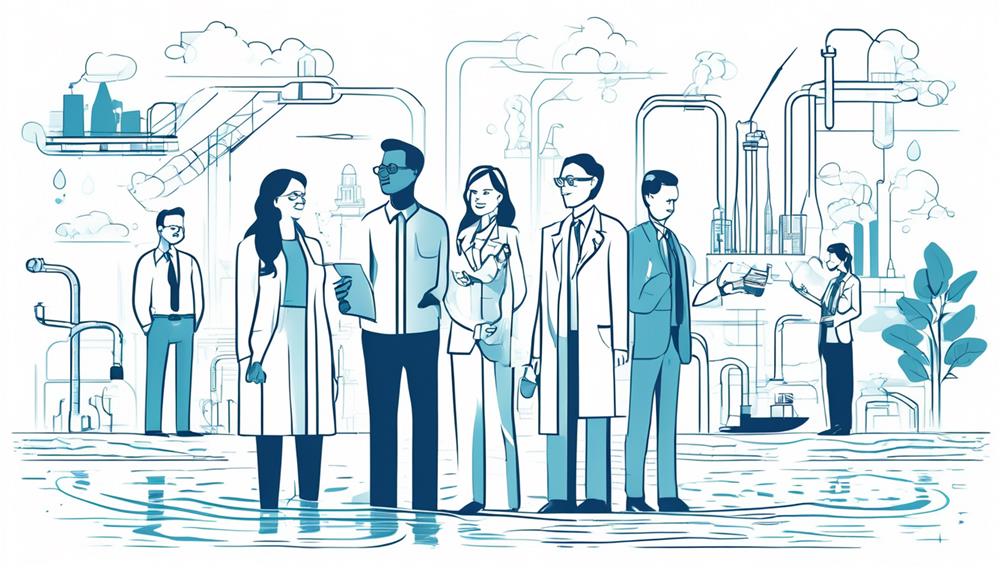Do you ever wonder about the key roles governments play in safeguarding our water resources?
From monitoring and enforcing regulations to setting water quality standards, there are crucial tasks that need to be carried out to control water pollution effectively.
But have you ever thought about the significance of funding allocation or public awareness programs in this realm?
As we explore the top 10 government roles in managing water pollution, you'll discover the intricate web of responsibilities that contribute to keeping our waters clean and safe.
Key Takeaways
- Regular monitoring and enforcement of water quality regulations through collaboration among government agencies, local authorities, and environmental organizations
- Setting water quality standards by establishing limits for pollutants and continuously assessing and adjusting standards for monitoring water sources
- Prioritizing funding and resource allocation for clean water technologies and infrastructure through collaboration with federal, state, and local agencies
- Collaborating with stakeholders by engaging with watershed councils, involving stakeholders in setting water protection goals, and encouraging public participation in defining measures
Monitoring and Enforcement of Regulations
Regular monitoring and enforcing of water quality regulations are crucial for ensuring compliance and identifying violations promptly. By actively monitoring water pollution levels and enforcing regulations, authorities can effectively safeguard water quality.
Leveraging advanced technologies and data analytics enhances the efficiency of monitoring efforts, allowing for the swift detection of any deviations from regulatory standards. Collaboration among government agencies, local authorities, and environmental organizations plays a pivotal role in conducting comprehensive monitoring and enforcement activities.
Implementing strict penalties for those who violate regulations acts as a deterrent, discouraging non-compliance and ultimately protecting water quality for all. Furthermore, regular reporting and public disclosure of monitoring results foster transparency and accountability in the enforcement of water quality regulations.
Through diligent monitoring and enforcement, the necessary steps can be taken to address water pollution effectively, ensuring a healthier environment for present and future generations.
Setting Water Quality Standards
When setting water quality standards, you establish limits for pollutants, keep an eye on water sources, and ensure everyone follows the rules.
It's like putting up guardrails to protect the water's health and the creatures living in it.
Establishing Pollution Limits
To effectively control water pollution, government agencies establish specific pollution limits for various contaminants in water bodies based on scientific research and community needs. Setting these limits is crucial for maintaining water quality and protecting our water resources. Here's why establishing pollution limits is essential:
- Preventing Contamination: By setting limits, authorities can prevent harmful contaminants from entering water sources.
- Regulating Pollution Levels: Standards provide a framework for monitoring and regulating pollution levels in water bodies.
- Proactive Conservation: Setting standards proactively ensures the protection and conservation of water resources.
- Environmental Regulation: These limits are a vital part of environmental regulation efforts to safeguard water quality for present and future generations.
Monitoring Water Sources
Monitoring water sources involves continuously assessing and adjusting water quality standards to safeguard public health and ecosystem integrity. Setting water quality standards ensures that water resources meet specific criteria for safe consumption and ecological health.
By identifying and regulating pollutants, pathogens, and physical parameters in the water, these standards help maintain water quality. They're established based on scientific research and data analysis to determine acceptable contaminant levels.
Collaboration among local, state, and federal agencies, scientific experts, and community stakeholders is crucial in this process. Effective monitoring and setting of water quality standards are essential for protecting public health, preserving ecosystems, and ensuring sustainable water resources for future generations.
Enforcing Regulatory Compliance
Enforcing regulatory compliance with water quality standards is essential for ensuring the safety and health of water bodies for public use. To effectively enforce these standards, government agencies play a crucial role by:
- Monitoring and Inspections: Regularly checking water resources for compliance with set quality standards.
- Enforcement Actions: Taking necessary steps against violators to ensure accountability.
- State Management: Collaborating with state authorities to implement and regulate water quality standards.
- Environmental Protection Agency (EPA): Overseeing the development, enforcement, and review of national water quality standards to protect the environment and public health.
Funding and Resource Allocation
You need to understand that budgeting for clean water and efficiently distributing resources are key to ensuring effective water quality protection programs. Without adequate funding and resource allocation, implementing crucial zoning ordinances and protection programs becomes challenging.
Look at successful programs like Michigan's Wellhead Protection program and Minnesota's Shoreland Management Classification System as examples that thrive due to proper funding and resource allocation.
Budget for Clean Water
To effectively protect water quality and promote environmental sustainability, securing adequate funding and resources for clean water initiatives is paramount. When it comes to budgeting for clean water, consider the following:
- Ensuring Adequate Funding: Allocate sufficient resources to address water quality improvement projects.
- Prioritizing Clean Water Technologies: Focus budget on implementing efficient clean water technologies and infrastructure.
- Monitoring and Enforcement: Allocate resources for monitoring and enforcing water quality regulations to maintain environmental quality.
- Research and Innovation: Invest in research and development for innovative water quality management solutions to safeguard water resources effectively.
Collaborating with federal, state, and local agencies is crucial in securing necessary funding for these vital clean water initiatives.
Resource Distribution Efficiency
Securing adequate funding and resources for clean water initiatives is pivotal for ensuring efficient resource distribution in controlling water pollution and promoting environmental sustainability. Proper allocation of funds is crucial for implementing effective water pollution control measures. Governments must prioritize funding for technological innovation in water quality management to optimize resource distribution.
Equitable distribution of funds and resources plays a significant role in achieving sustainable water quality conservation. Adequate funding and resource allocation are essential for the successful implementation of water quality policy frameworks, ensuring the efficient management of water resources at the local level and effective State Management. By investing in these areas, governments can foster local development while safeguarding water quality for future generations.
Public Awareness and Education Programs

Public awareness campaigns serve as powerful tools in educating communities about the importance of addressing water pollution. Government roles in promoting public awareness and education programs are crucial for fostering a proactive approach towards water quality protection. Here are four key aspects to consider:
- Informing and Engaging: These programs inform the public about water pollution issues and engage them in finding solutions.
- Raising Awareness: By highlighting the impacts on public health and ecosystems, these initiatives stress the importance of combating water pollution.
- Promoting Sustainable Behaviors: Public education efforts emphasize water conservation and sustainable practices to reduce pollution levels.
- Utilizing Diverse Channels: Effective programs utilize workshops, community events, educational materials, and digital platforms to reach a wide audience and encourage active participation.
Through these initiatives, individuals are empowered to contribute to the protection of water quality and embrace a collective responsibility for environmental stewardship.
Research and Data Collection
In understanding the current state of water pollution and its environmental impact, research and data collection play a pivotal role in formulating effective protection policies. Gathering data on pollutant levels, sources, and distribution is crucial for shaping water quality protection policies.
Through the utilization of advanced technologies and remote sensing tools, accurate and real-time data on water quality can be collected. Long-term research and data collection efforts are instrumental in identifying trends, evaluating protection programs' effectiveness, and planning sustainable water resource management.
Collaboration among governments, academia, and the private sector in research and data collection is essential for informed decision-making and policy development. By working together, these entities can ensure that data-driven insights guide integrated water resources management and conservation efforts.
The Department of Natural Resources, along with other relevant agencies, plays a significant role in coordinating research initiatives to safeguard our water resources effectively.
Collaborating With Stakeholders

To enhance water resource protection efforts, fostering collaboration with stakeholders is essential. By engaging with organizations like watershed councils and other stakeholders, a more comprehensive approach to water protection can be achieved. Involving stakeholders in setting water protection goals and standards ensures that all voices are heard, leading to more effective management strategies.
Encouraging public participation in defining constraints and acceptable measures through master plan adoption helps in aligning state regulations with community needs and environmental goals. Furthermore, raising awareness and facilitating community engagement through clean-up initiatives, education programs, and events not only educates the public but also garners support for environmental initiatives.
Empowering residents through volunteer opportunities allows them to play an active role in protecting water sources, fostering a sense of ownership and responsibility for the environment. By collaborating with stakeholders, the state can create a network of support for sustainable water management practices.
Implementing Pollution Prevention Measures
Alright, let's talk about how to tackle water pollution head-on!
You'll explore source control strategies to nip pollution in the bud.
Treatment technology options to clean up the mess.
And regulatory compliance enforcement to keep things in check.
Ready to roll up your sleeves and make a splash in the fight against water pollution?
Source Control Strategies
When it comes to implementing pollution prevention measures through source control strategies, embracing advanced technologies for water treatment is key. By incorporating innovative tools like remote sensing and data analytics, monitoring water bodies becomes more efficient.
Sustainable practices such as rainwater harvesting and water-efficient techniques play a crucial role in conserving water resources. Encouraging sustainable production through trade partnerships and resource efficiency mechanisms contributes to the overall goal of water quality management.
Treatment Technology Options
Embrace cutting-edge treatment technologies to elevate water quality standards and combat pollution effectively. The government plays a crucial role in implementing advanced water treatment methods to tackle water pollution. By utilizing innovative wastewater treatment processes, such as membrane bioreactors and advanced oxidation, water purity can be significantly enhanced. Additionally, incorporating remote sensing tools and data analytics aids in monitoring water bodies more efficiently. Providing real-time water quality information through mobile apps ensures transparency and public awareness. Sustainable practices like green infrastructure further contribute to water quality conservation efforts. By investing in these treatment technology options, the government demonstrates its commitment to safeguarding water resources for current and future generations.
| Advanced Treatment Technologies | Remote Sensing Tools | Sustainable Practices |
|---|---|---|
| Membrane Bioreactors | Data Analytics | Green Infrastructure |
| Advanced Oxidation | Monitoring Efficiency | Eco-friendly Solutions |
| Real-time Water Quality Apps | Transparency | Conservation Efforts |
Regulatory Compliance Enforcement
To ensure the effectiveness of cutting-edge treatment technologies in elevating water quality standards and combatting pollution, the government plays a critical role in monitoring and enforcing compliance with pollution prevention measures set by regulations.
Here are four key ways in which regulatory compliance enforcement aids in controlling water pollution:
- Monitoring and enforcing compliance: Ensuring businesses adhere to pollution prevention guidelines set by the Clean Water Act.
- Implementing pollution control measures: Controlling and reducing pollution from industrial, agricultural, and municipal sources.
- Conducting inspections and audits: Regular checks to guarantee adherence to pollution prevention guidelines in public water systems.
- Enforcing penalties for non-compliance: Levying fines on entities that violate pollution prevention regulations, promoting accountability and deterrence.
Emergency Response Planning
In Emergency Response Planning, swift and effective strategies are crucial for addressing water pollution incidents promptly. This planning involves developing protocols for rapid deployment of resources and personnel during water contamination emergencies. Communication and coordination among government agencies, first responders, and stakeholders are vital for a successful response. Regular training, drills, and simulations help test the readiness of these plans. Continuous evaluation and updates based on lessons learned and environmental changes ensure preparedness.
Emergency response planning plays a significant role in water governance by safeguarding drinking water sources and public health. By having robust emergency plans in place, governments can mitigate the impacts of pollution events on drinking water quality. These plans also enhance overall water management strategies by emphasizing proactive measures to address contamination incidents swiftly. Effective emergency response planning is a cornerstone of government efforts to protect water resources and ensure access to safe drinking water for all.
Policy Development and Legislation

Developing effective policies and legislation is essential for controlling water pollution and safeguarding water resources. When it comes to policy development and legislation, here are four key aspects to consider:
- Local Involvement: Engaging local communities in the policymaking process ensures that regulations are relevant to specific regional needs and challenges.
- Sustainable Water Use: Policies should promote sustainable water use practices to prevent overexploitation of water resources and minimize pollution.
- Research-Based Approach: Developing policies based on scientific research and data analysis helps create effective solutions to address water pollution issues.
- Enforcement Mechanisms: Implementing strong enforcement mechanisms within legislation is crucial to ensure compliance with water quality standards and pollution control measures.
Inspections and Compliance Checks
Inspections and compliance checks are essential tools for ensuring industries and facilities adhere to water quality regulations. Regular inspections play a crucial role in identifying and addressing potential sources of water pollution, safeguarding our precious water resources.
By conducting compliance checks, government agencies ensure that businesses meet the required standards for water quality and pollution control, promoting sustainable practices. These measures are vital for enforcing environmental laws and regulations related to water quality, mitigating the impact of industrial activities on water resources.
Through monitoring and regulating compliance, authorities can work towards maintaining a healthy and sustainable water ecosystem for present and future generations. By emphasizing the importance of inspections and compliance checks, we can strive towards a cleaner, safer, and more sustainable environment where water resources are protected and preserved for the benefit of all.
Frequently Asked Questions
What Has the Government Done to Stop Water Pollution?
To stop water pollution, the government enforces regulations on industries, monitors water quality, and educates communities. By setting standards, conducting inspections, and cleaning up polluted sites, they work to protect our water sources.
What Are the 10 Prevention of Water Pollution?
To prevent water pollution, you can reduce plastic waste, properly dispose of chemicals, conserve water, and support eco-friendly policies. By taking small actions like these, you contribute to cleaner water sources for everyone to enjoy.
What Are the Roles in Preventing Water Pollution?
You play a vital role in preventing water pollution through proper waste disposal, reducing chemical usage, and supporting water conservation efforts. Your actions today ensure clean water for future generations.
What Part Do Governments Play in Supplying Clean Drinking Water?
Governments play a vital role in supplying clean drinking water by regulating water sources, enforcing quality standards, funding infrastructure, and monitoring water treatment processes. Your commitment ensures safe and accessible drinking water for all.
Conclusion
Now that you've learned about the top 10 government roles in controlling water pollution, remember that they're the guardians of our precious water resources.
Just like a shield protects a knight in battle, these roles protect our environment from harm.
By working together with these government agencies, we can ensure that our water stays clean and safe for generations to come.
So, let's join forces and be the protectors of our planet's lifeblood – water.
